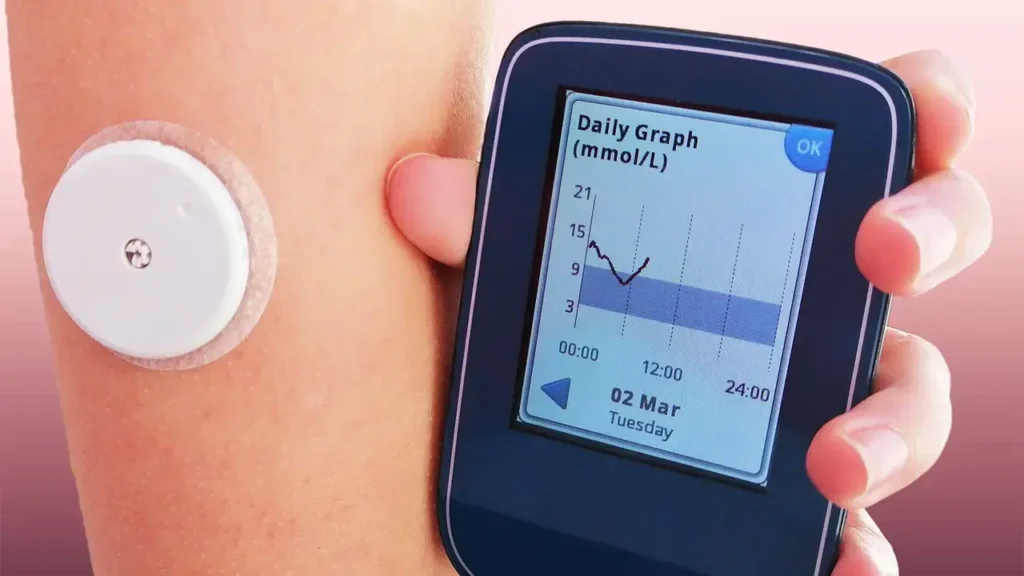In terms of managing diabetes, Continuous Glucose Monitors and flash glucose monitoring have changed the game by providing a discrete and practical substitute for conventional glucose monitoring techniques. Without the need for fingerstick tests, these cutting-edge gadgets give users real-time glucose levels, enabling them to easily manage their diabetes.
Knowing How to Use Flash Glucose Monitoring
An upper arm-worn tiny sensor and a smartphone app or reader are the two components of flash glucose monitors, such as the FreeStyle Libre system. Users get a complete picture of their glucose levels day and night because of Continuous Glucose Monitors’ continuous measurement of the interstitial fluid’s glucose levels.
The Benefits of Convenient Flash Glucose Monitoring
Convenience
By doing away with the need for frequent fingerstick tests, Flash Glucose Monitors provide users with a more convenient and pleasant monitoring experience.
Real-Time Data
By just scanning the sensor, users of Flash Glucose Monitors can instantly see their glucose results. More educated decisions about medication, exercise, and diet are possible thanks to this real-time data.
Trend Analysis
By offering information on glucose patterns and trends, Flash Glucose Monitors assist users in understanding how various circumstances impact their blood sugar levels over time.
Discreet Design
Flash glucose monitors’ discrete design makes it possible to monitor glucose levels inconspicuously, allowing users to check their levels whenever and wherever they choose.
Improving Care for Diabetes
By offering a more convenient and approachable monitoring option, Flash Glucose Monitoring has completely changed the way people with diabetes manage their condition. With the use of Continuous Glucose Monitors, people with diabetes can more efficiently monitor their blood sugar levels, which promotes better glycemic control and better health outcomes.
Cost and Availability
Even though there are several advantages to using a flash glucose monitor, accessibility and cost are still major factors for many people. The use of Flash Glucose Monitors is subject to variations in insurance coverage policies, including Medicare and private insurance plans. People must fight for access to these game-changing Continuous Glucose Monitors and be aware of their alternatives for insurance coverage.
Explore More LCD Policies for Implantable Continuous Glucose Monitors
FAQs Regarding Continuous Glucose Monitors’ Flash Glucose Monitor
How do glucose monitors that flash work?
A tiny sensor that is worn on the back of the upper arm to continually measure the amount of glucose in the interstitial fluid makes up a flash glucose monitor. To get real-time glucose levels, users scan the sensor using a smartphone app or reader.
Does the flash glucose meter hurt?
Since flash glucose monitoring doesn’t involve fingerstick testing, it’s usually painless. Users do not feel the sensor after it is in place; it is put beneath the skin using a tiny applicator, much like a tiny needle.
How often must I check the sensor?
To receive glucose readings, users usually need to scan the sensor once every eight hours using the reader or app. Those who need closer supervision, however, might benefit from more frequent screening.
I have a flash glucose meter; can I swim or take a shower?
Due to the water resistance of flash glucose monitors and Continuous Glucose Monitors, users can shower, swim, and partake in other aquatic activities while the sensor is on. On the other hand, extended exposure to water or submersion below the advised depth may compromise sensor performance.
Do glucose monitors that flash require calibration?
Since the sensor on a Continuous Glucose Monitors’ flash glucose monitor continuously measures glucose, fingerstick tests are not necessary for calibration. It might be suggested, therefore, that users conduct sporadic fingerstick tests to confirm sensor accuracy.
What is the lifespan of a flash glucose sensor?
Flash glucose sensors usually require replacement after up to 14 days of use. When it comes to wear, replacement, and insertion of sensors, users should adhere to the manufacturer’s instructions.
Do insurance policies cover flash glucose monitors?
Continuous Glucose Monitors’ Flash glucose monitor coverage differs depending on the insurance company and plan. While some insurance plans might pay for flash glucose monitors, others would not, requiring upfront costs or a prescription.
Are flash glucose monitors safe for kids to use?
Under the supervision of a healthcare professional, children and adolescents with diabetes can utilize flash glucose monitors. Smaller arms may be able to fit into the sensor’s size range, and using and scanning the sensor may need parental supervision.
Are there any restrictions on the use of glucose monitors that flash?
Although Continuous Glucose Monitors flash glucose monitors are quite beneficial, there are several drawbacks to be aware of. Users should be mindful of variables that can affect sensor readings, such as excessive humidity or extreme temperatures, as some medications or conditions may have an impact on sensor accuracy.
If I have an allergy or sensitivity to adhesives, can I still use a flash glucose monitor?
Before utilizing a flash glucose monitor, anyone with allergies or adhesive sensitivity should speak with their healthcare physician. The glue used to hold the sensor in place may cause skin irritation or allergic reactions in certain users.
In Summary
A major development in the treatment of diabetes is Continuous Glucose Monitors’ flash glucose monitoring, which provides a discrete, easy-to-use, and practical substitute for conventional glucose monitoring techniques. With the help of trend analysis, real-time data, and increased convenience, Flash Glucose Monitors enable people with diabetes to take charge of their health and live longer better lives. The future of diabetes control appears more promising than ever as these gadgets develop and get better.


